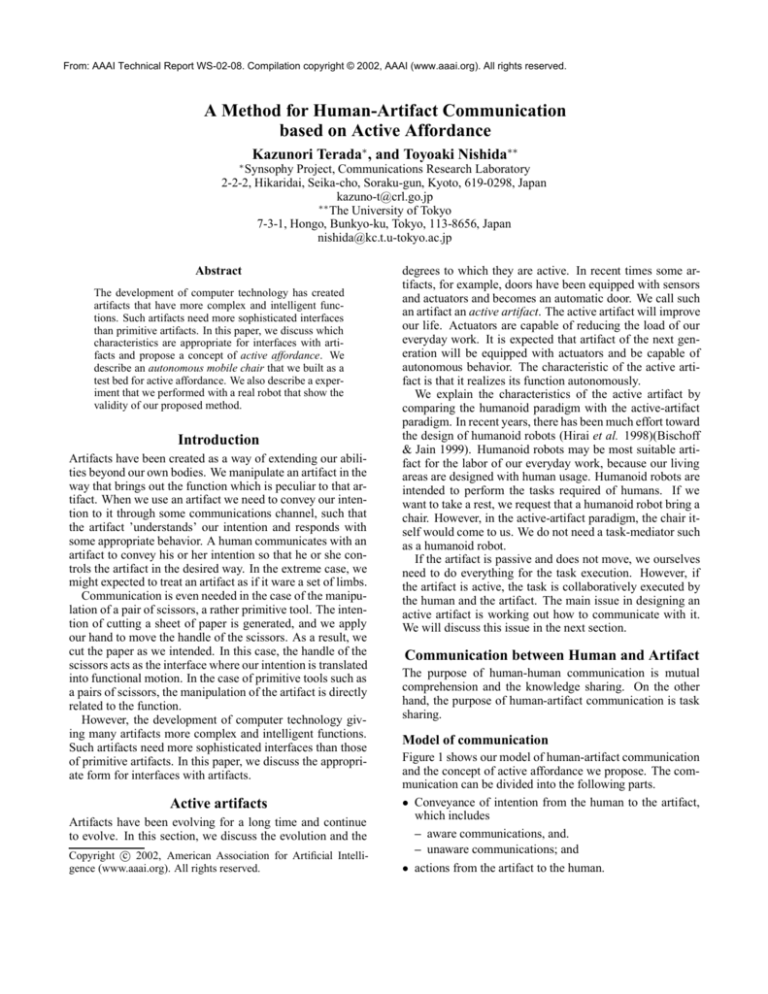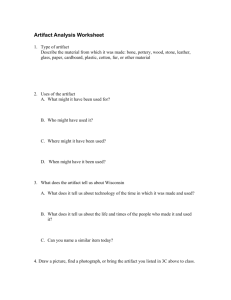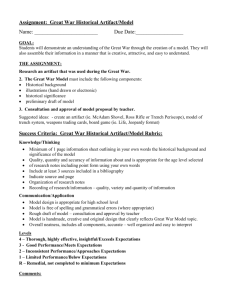
From: AAAI Technical Report WS-02-08. Compilation copyright © 2002, AAAI (www.aaai.org). All rights reserved.
A Method for Human-Artifact Communication
based on Active Affordance
∗
Kazunori Terada∗ , and Toyoaki Nishida∗∗
Synsophy Project, Communications Research Laboratory
2-2-2, Hikaridai, Seika-cho, Soraku-gun, Kyoto, 619-0298, Japan
kazuno-t@crl.go.jp
∗∗
The University of Tokyo
7-3-1, Hongo, Bunkyo-ku, Tokyo, 113-8656, Japan
nishida@kc.t.u-tokyo.ac.jp
Abstract
The development of computer technology has created
artifacts that have more complex and intelligent functions. Such artifacts need more sophisticated interfaces
than primitive artifacts. In this paper, we discuss which
characteristics are appropriate for interfaces with artifacts and propose a concept of active affordance. We
describe an autonomous mobile chair that we built as a
test bed for active affordance. We also describe a experiment that we performed with a real robot that show the
validity of our proposed method.
Introduction
Artifacts have been created as a way of extending our abilities beyond our own bodies. We manipulate an artifact in the
way that brings out the function which is peculiar to that artifact. When we use an artifact we need to convey our intention to it through some communications channel, such that
the artifact ’understands’ our intention and responds with
some appropriate behavior. A human communicates with an
artifact to convey his or her intention so that he or she controls the artifact in the desired way. In the extreme case, we
might expected to treat an artifact as if it ware a set of limbs.
Communication is even needed in the case of the manipulation of a pair of scissors, a rather primitive tool. The intention of cutting a sheet of paper is generated, and we apply
our hand to move the handle of the scissors. As a result, we
cut the paper as we intended. In this case, the handle of the
scissors acts as the interface where our intention is translated
into functional motion. In the case of primitive tools such as
a pairs of scissors, the manipulation of the artifact is directly
related to the function.
However, the development of computer technology giving many artifacts more complex and intelligent functions.
Such artifacts need more sophisticated interfaces than those
of primitive artifacts. In this paper, we discuss the appropriate form for interfaces with artifacts.
Active artifacts
Artifacts have been evolving for a long time and continue
to evolve. In this section, we discuss the evolution and the
c 2002, American Association for Artificial IntelliCopyright gence (www.aaai.org). All rights reserved.
degrees to which they are active. In recent times some artifacts, for example, doors have been equipped with sensors
and actuators and becomes an automatic door. We call such
an artifact an active artifact. The active artifact will improve
our life. Actuators are capable of reducing the load of our
everyday work. It is expected that artifact of the next generation will be equipped with actuators and be capable of
autonomous behavior. The characteristic of the active artifact is that it realizes its function autonomously.
We explain the characteristics of the active artifact by
comparing the humanoid paradigm with the active-artifact
paradigm. In recent years, there has been much effort toward
the design of humanoid robots (Hirai et al. 1998)(Bischoff
& Jain 1999). Humanoid robots may be most suitable artifact for the labor of our everyday work, because our living
areas are designed with human usage. Humanoid robots are
intended to perform the tasks required of humans. If we
want to take a rest, we request that a humanoid robot bring a
chair. However, in the active-artifact paradigm, the chair itself would come to us. We do not need a task-mediator such
as a humanoid robot.
If the artifact is passive and does not move, we ourselves
need to do everything for the task execution. However, if
the artifact is active, the task is collaboratively executed by
the human and the artifact. The main issue in designing an
active artifact is working out how to communicate with it.
We will discuss this issue in the next section.
Communication between Human and Artifact
The purpose of human-human communication is mutual
comprehension and the knowledge sharing. On the other
hand, the purpose of human-artifact communication is task
sharing.
Model of communication
Figure 1 shows our model of human-artifact communication
and the concept of active affordance we propose. The communication can be divided into the following parts.
• Conveyance of intention from the human to the artifact,
which includes
– aware communications, and.
– unaware communications; and
• actions from the artifact to the human.
Although affordance in the original concept is realized by
the user’s action (Norman 1988), active affordance is realized by the artifact’s action. Affordance which is not found
by a human is meaningless. The reasons for affordance not
being found are as follows.
• The function of the artifact is unknown.
• A user does not know how to use the artifact (the user is,
however, conscious of his intention).
• A user is not even conscious of his intention.
Figure 1: Communication between human and artifact
While human-human communication is bidirectional,
human-artifact communication is mono-directional. A human has an intention when he is going to carry out some
task. The intention is conveyed to the artifact through the
communications channel. There are two modes for the communications channel; 1) aware communications, the means
of which include natural language, sign language, and gesture and 2) unaware communication channel, which refers
to nonverbal behavior.
If an artifact has a modality for aware communications,
a human is able to use the channel for aware communications by utilizing the methods for human-human communication. However, the communications protocol should be
predefined and the system needs a large database of vocabulary.
Some psychological researchers have concluded that
more than 65 percent of the information exchanged during
a face-to-face interaction between humans is expressed nonverbal (Argyle 1988). The unaware communications channel is important for human-human communication. Cassell
pointed out that speech and nonverbal behavior join together
to convey the communicative intent of a speaker (Cassell
2000). The unaware communications channel should also
be important in human-artifact communication. Unaware
communications is used as a means for conveying human
intention in communications between humans and artifacts.
An intelligent active artifact is able to completely understand
the human’s intention.
Active affordance solves these problems.
Our implementation
of the comprehension of intention
Our use of the aware communications channel and the unaware communications channel as means for the ‘comprehension’ of intention must be appropriate. In this work, we
use the following methods.
Channel for aware communications
We use gesture as one means for aware communication. We
thus compare the user’s motion with a set of predetermined
gesture pattern.
Channel for unaware communications
We use following heuristics to realize the unaware communication.
• Physical contact always occurs in object manipulation,
and indicates a critical state.
• The distance between the surfaces of user’s body and the
artifact is reduced by the action of reaching.
• This reduction of distance indicates that the user intends
to manipulate the given artifact.
Method of behavior generation
Once the intention has been ‘understood’ by the artifact, it
should produce behavior that is appropriate in response to
the intention. In this section, we describe the method used
to generate such behavior.
Active Affordance
The user’s intention is revealed in unconscious motion. The
action generated when a human manipulates some artifact
varies according to the artifact’s physical properties and
functions. The artifact might take advantage of the peculiarities of the various forms of motion to detect the user’s
intention. The artifact then to complement the user’s actions.
We call such an action as active affordance.
The concept of affordance was introduced by the psychologist J.J.Gibson (Gibson 1979). Affordance refers to
the possibilities for the action that available in the environment or the object, and which are revealed by interaction
between the human and the environment. For example, the
affordance of a chair is such that it allows to a human to sit
on the chair, but is not manifested until the human generates
the action of sitting down.
Affordance distance
In the following sub-section, we describe an architecture
which allows an artifact to autonomously realize its function. Firstly, we consider a method of describing the functional relation between a human and an artifact based on
the concept of affordance. As was mentioned by Gibson,
a physical relation and, in particular, relation of surfaces between the human’s body and the environment is important
for the human’s behavior in physical world. Such a relation is described relative to the human’s body as a standard.
In order to describe the relation between the surfaces of a
human’s body and the surfaces of the object (artifact), we
introduce the concept of affordance distance.
Affordance distance has a value and defined in the following way.
Figure 2: Affordance distance.
• Affordance distance will be as its minimum value at the
end of an action sequence, i.e., a tactile state.
• Affordance distance increases as the agent becomes increasingly distant from the tactile state.
• Affordance distance is defined between a point on artifact’s body and a point on the human’s body.
For example, in the case of the chair drawn in Figure 2, the
affordance distance will be minimum value when the human
is sitting down, and will increase as the human goes away the
chair. Affordance distance is not Euclidean but corresponds
to the cost of the action which is required of the artifact when
it goes to contact with human. That is because the optimal
action path that minimizes the distance between two points
is not necessarily the shortest distance. The optimal action
path depends on the locomotive ability of the artifact and the
relative angle between the two surfaces.
Calculation and minimizing of the affordance
distance
The purpose of an artifact is to search for and move to a
state where the affordance distance is at its minimum. In
this subsection we describe a method for calculating the affordance distance and the method for controlling the artifact.
We employ a utility function to express the affordance distance. The utility function is a widely used in a research in
autonomous agents (Sutton & Brato 1998). The utility function is capable of representing the distance to the goal state,
considering the locomotive ability of agent.
The utility value of each state is calculated by the following equation.
a
U (s) = R(s) + max
Mss
(1)
U (s )
a
s
a
where Mij
is the transition probability of reaching state j
a
if an action a is taken in state i. M ss
is obtained by the
repetition of the same action from the same state;
ns
a
Mss
(2)
=
nas
where nas is the number of times of the action a which is
carried out at state s, and n s is the number of times the
state s is reached. R(i) is a reward function which returns
the value of the reward in state i. We give a reward when a
certain point on the artifact’s body comes into contact with a
certain point on a human’s body in an appropriate way, i.e.,
where the affordance distance is at its minimum. The tactile
condition is
(x, y, z)p = (x, y, z)q ∧ (θ, φ, ϕ)p = −(θ, φ, ϕ)q . (3)
where (x, y, z)p are the coordinates of the point on the human’s body and (x, y, z) q are the coordinates of the point on
the artifact’s body and (θ, φ, ϕ) p and (θ, φ, ϕ)q are the angles of the normal vectors which are normal to the surfaces
at the respective points.
In our method we use a simple iterative algorithm called
value iteration to calculate the utility value of each state.
The value iteration procedure is performed according to the
following equation.
a
Ut+1 (s) ← R(s) + max
Mss
(4)
Ut (s ).
a
s
Where Ut (s) is the utility value of s after t iterations. The
utility value is known to converge to the correct value when
t → ∞.
Given a utility function U and if a state transition holds
the Markov property, the optimal policy for the Markov decision problem is calculated in the following way.
a
f (i) = arg max
Mij
U (j).
(5)
a
j
Where arg max a f (a) returns the value of a that produces
the highest value for f (a).
Experimental results
To show the validity of our proposed method, we performed
experiments using a computer simulation and a real robot. In
this section we describe our experimental system and results.
Autonomous mobile chair
We have built an autonomous mobile chair as an example of
the active artifact. The purpose of the autonomous mobile
chair is to reach its back reclining on human’s back.
We remodeled some parts of an aluminum chair to allow it
to move around (See Figure 3). The chair has five legs, radiating in every-spaced directions, and each leg has a caster
which freely rotates in the horizontal plane. In our system, we replaced two of the casters with powered wheels,
each of which is fixed to the leg. The autonomous mobile
chair is equipped motion-capture system made by Ascension Technology, which enables measurement of the position and orientation of the chair’s body. The motion-capture
system employs pulsed-DC magnetic-field transmission and
sensing technology to measure the positions and orientations
of miniaturized sensors that are attached to the measuring
equipment. The autonomous mobile chair is controlled by
a Linux PC to which it is connected via RS232C cable. A
subject in this experiment also has to carry a motion sensor
so that the autonomous mobile chair is able to determine the
reaching point.
Figure 5: The model of the environment and state space.
Figure 3: The autonomous mobile chair.
Modeling of the autonomous mobile chair and state
space
In order to perform computer simulation, the environment
and the autonomous mobile chair ware modeled in the following way. The environment is a floor of 5m square. The
size of the chair and the arrangement of its wheels is as
shown in figure 4. The state space is constructed in the following way (see figure 5). To simplify the simulation, we assume that the dimension of two for both the autonomous mobile chair and the environment, that is, height is disregarded
and the artifact is able to only move in the 2D plane. As
a result, the dimension of the state space is three; (x, y, θ).
The floor is divided into a 50 × 50 grid. The angle of the
normal vector of the surface is discretized into 16 steps. As
Figure 6: The utility function. The goal state is (40, 40, 0).
The utility value is the mean value for the 16 states of θ.
a result, the discrete state space has 50 × 50 × 16 states. We
also assume that we are able to send six action commands to
the autonomous mobile chair. The commands are executed
by specifying the speeds of the motors. The commands are
A1(−V, V ), A2(0, V ), A3(V, V ), A4(V, 0), A5(V, −V ),
and A6(−V, −V ). In this experiment, V is 0.3m/sec. We
define the action unit as the segment of the artifact’s motion
that precedes the observation of a change of state.
Calculation of utility value
Figure 4: The model of an autonomous mobile chair.
Firstly, we calculated the transition probability model. Each
of the six action commands is executed from 100 uniform
points in a grid, i.e., n as in equation (2) is 100. This operation is performed for each of the 16 angles. The transition
probability model for a certain one grid position is applied
to other grid position since the transition probability is equal
for every grid position.
Next, the utility function is calculated. The goal point,
i.e., the point of contact, is set as (40, 40, 0). The reward
Conclusion
In this paper, we discussed an appropriate interface for artifacts and proposed the concept of active affordance. Active
affordance is valid in the following cases:
• where the functions of the artifact are unknown;
• where the user does not know how to use the artifact;
(a)
Start:
(10, 10, −π/2)
(b)
Start:
(10, 10, π/2)
Figure 7: Generated paths.
• where the user is not conscious of even his intention.
To realize active affordance, we introduced the concept of
affordance distance. We employ a utility function to express
the affordance distance. We built an autonomous mobile
chair as an example of an active artifact that embodies the
principles stated above. To show the validity of our proposed
approach, we carried out experiments by computer simulation and real robot. Our experimental results show that the
autonomous mobile chair is able to generate an appropriate
path to the goal by means of the acquired utility function.
We can thus safely say that the affordance distance is a suitable means for the realization of implicit communication.
We also gave a result of an experiment in the comprehension of intention and the generation of behavior.
References
Figure 8: Intention understanding and behavior generation
given for reaching the goal point has a value of 1. Figure 6
shows the utility function as calculated by using the dynamic
programming algorithm.
Reaching the goal
To show the validity of the calculated utility function, we
carried out two cases of reaching experiments in computer
simulation. One of the cases, i.e., case (a), is that where the
state of starting point is (10, 10, −π/2) while in the other
case, i.e., case (b), the state is (10, 10, π/2). Figure 7 shows
the paths generated in the two cases. In case (a), the autonomous mobile chair changes direction gradually as it approaches the goal. In case (b), the autonomous mobile chair
reverses once, changes direction, and then proceeds to the
goal. In both cases, the autonomous mobile chair generates
an appropriate path and reaches its goal.
Comprehension of intention and generation of
behavior
Figure 8 shows an experiment in the comprehension of intention and generation of behavior. The subject generates a
beckoning gesture: palm down, the hand flaps at the wrist.
The gesture is perceived by the autonomous mobile chair
through its motion capture system. The chair then moves to
the subject.
Argyle, M. 1988. Bodily Communication. Methuen & Co.
Bischoff, R., and Jain, T. 1999. Natural communication
and interaction with humanoid robots. In Second International Symposium on Humanoid Robots, 121–128.
Cassell, J. 2000. Nudge nudge wink wink: Elements
of face-to-face conversation for embodied conversational
agents. In Cassell, J.; Sullivan, J.; Prevost, S.; and
Churchill, E., eds., Embodied conversational agents. The
MIT Press. chapter 1, 1–27.
Gibson, J. J. 1979. The Ecological Approach to Visual
Perception. Houghton Mifflin Company.
Hirai, K.; Hirose, M.; Haikawa, Y.; and Takenaka, T. 1998.
The development of honda humanoid robot. In IEEE International Conference on Robotics and Automation, 1321–
1326.
Norman, D. A. 1988. The psychology of everyday things.
Basic Books Inc.
Sutton, R. S., and Brato, A. G. 1998. Reinforcement Learning. The MIT Press.







